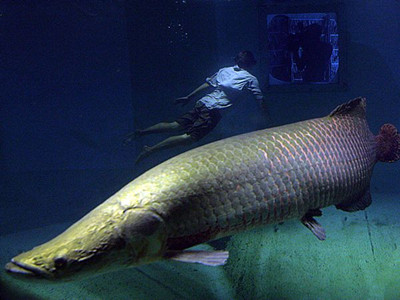
Megafishes
Giant freshwater fish from around the world clock in as 2011's most popular environment gallery on nationalgeographic.com. Increasingly rare because of fishing, pollution, and loss of habitat due to human activity, these so-called megafishes can be indicator species of aquatic ecoystems.
National Geographic Explorer Zeb Hogan has wrangled, photographed, and studied many of these freshwater monsters. Some, like the Chinese sturgeon, are "living fossils" that have changed little over millions of years.
Pictured is an arapaima fish at an aquarium in Manaus, Brazil. This South American giant can reach lengths of more than 10 feet (3 meters) and weigh upwards of 400 pounds (180 kilograms).
Like several megafish species in our gallery, the arapaima is the focus of conservation projects, which may be racing against time to save these animals in the wild.
巨型淡水魚
在2011年美國《國家地理雜志》網站的環境圖集中,巨型淡水魚的照片成為最大熱門。由于過度捕撈、環境污染以及人類活動導致的棲息地減少,巨型淡水魚的數量不斷萎縮,它們的命運成為淡水生態系統物種的一個寫照。
《國家地理雜志》的探險家澤布-霍甘曾對很多巨型淡水魚進行研究并拍攝照片。包括中國鱘魚在內的一些淡水魚都是“活化石”,在數百萬年的歲月變遷中,它們幾乎未發生任何改變。照片展示的是一條巨滑舌魚,在巴西馬瑙斯的一個水族館拍攝。這種南美巨型魚的身長可超過10英尺(約合3米),體重超過400磅(約合180公斤)。與《國家地理雜志》圖集中展現的其他巨型淡水魚一樣,巨滑舌魚也是一個保護重點。為了拯救野外的巨型淡水魚,保護人員需要與時間賽跑。











